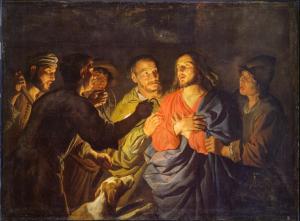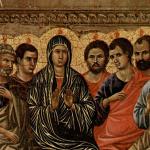Applying Understanding of the Mohar to Soteriology
Christians are very familiar with the formulation that Jesus’s Passion and death on a cross was the “price He paid” to save us. What exactly that means has been the subject of considerable debate through the centuries. Paid to whom and for what? To the Devil to ransom us from his evil dominion? To God the Father as satisfaction for the demands of justice? The first explanation was dominant in first millennium Christianity; the second dominant since St. Anselm proposed it around the turn of the 12th century. Modern times have also seen the emergence of the scapegoat theory, which basically casts the “payment” as a misguided belief of society that some innocent scapegoat must pay a “debt to society” to restore peace.

While there may be some truth to all of the above, the satisfaction theory, especially in its penal substitutionary atonement form, has proven least satisfying to believers who find this difficult to reconcile with God’s forgiving nature. Why wouldn’t He simply forgive the debt of sin, as in the parable of the two debtors; why would God be more “satisfied” by His own Son being tortured and killed? St. Anselm proposed the theory because he could not understand why God would owe a debt to Satan, nor why the second Person of the Trinity would need to become human for this purpose. But if we understand Jesus’s Passion and death as being offered to Satan as the price of betrothing us, both of Anselm’s questions can be neatly answered: we are born into (or have sold ourselves into) Satan’s headship as our abusive father/husband/master, and Jesus needed to become human like us to offer betrothal that dissolves our ties to the lord of this world and makes us members of God’s household.
The concepts of a ransom price and a bride price are not competing interpretations, but related concepts. Keep in mind that the legal status of women in ancient Israel was not much different from that of slaves. Women were defined by whom they “belonged to,” and had no juridical status of their own (e.g. could not testify in court, could not inherit property, etc.). Likewise, the roles of bridegroom and redeemer are elided in the Old Testament, especially in the form of the kinsman redeemer (goel), a male relative of a widow or orphan who pays a ransom price to release such a person if, in destitution, they have sold themselves into slavery, or who marries the widow of his deceased brother to give her sons on his behalf. The great prophecy of the coming Redeemer (goel) in Isaiah 49-55 is full of marriage imagery as much as the freeing of captives. Isaiah 50:1-2a is particularly indicative of the similarity of these concepts:
Thus says the Lord: Where is the bill of divorce with which I dismissed your mother? Or to which of my creditors have I sold you? It was for your sins that you were sold, for your crimes that your mother was dismissed.
Why was no one there when I came? Why did no one answer when I called? Is my hand too short to ransom? Have I not the strength to deliver?
The second verse seems to evoke the bridegroom returning in the night for the nissuin and finding no one ready to go with him. And the marginalia of my New American Bible Personal Study Edition explains “since there was no bill of divorce, the bond between the Lord and his people still exists and he will ultimately save them.” In other words, we are solely responsible for putting ourselves into bondage to the Devil, whether we call him “master” because he is our “father” (cf. John 8:44, I John 3:8) or our slavemaster, but God still desires to rescue us, no expense spared.
Understanding the price that God the Father paid by surrendering to death His only begotten Son as a mohar helps to explain much more, however, than interpreting it merely as the ransom paid to free a slave. When God led the Israelites out of Egypt, He paid no price to Pharaoh to do so. He simply liberated them by His almighty power, and Pharaoh and his people paid the price of resistance. But then the Israelites quickly lapsed into the worship of false gods, and transgressions of the law God gave for their benefit. They were liberated but not transformed, and quickly re-enslaved themselves figuratively. But marriage is a transformative act. Beyond simple redemption from an oppressive father-master, it effects becoming one flesh, sharing a name and fruitfulness, and even a transformed nature. But according to the law the Jews believed was given to them by God, a marriage must be preceded by payment of a bride-price. An exodus can be delivered easily by God, but in the worldview of the Jews, theosis (the process of gradually sharing more and more in the Divine nature) would require a payment from God the Father to our worldly master.
This helps explain I Cor 6:12-7:40, which embeds the phrase “you have been purchased with a price” twice within an extended discussion about sexual morality, the superiority of virginity, and how to live in Christ as a married person. “Do you not know that your body is a sanctuary of the Holy Spirit within you, which you have from God, and that you are not your own? For you were bought with a price; therefore glorify God in your body.” (v. 19-20) If we are consecrated to God, belonging to Him as His bride, would it be adulterous to remain married or get married to another human being? St. Paul assures the Corinthians in the following chapter that marriage in this world is still permissible, if not ideal. He also draws out the implications of the fact that, in Christ, there is no male or female (Gal. 3:28), only members of the Bride of Christ, by applying the unilateral ownership and conjugal rights of Jewish marriage law reciprocally (I Cor 7:3-4). (There are many more passages in the New Testament mentioning “purchase” or “ransom” that can be illuminated similarly, but in the interest of length I will confine myself to this one for now.)
Jacob offered 7 years of servitude to Laban as the price to marry Rachel, whom he loved, and then was required to complete 7 more because Laban proved to be a deceitful father. Just so God offered the very life of His Son to espouse us, and the Devil thought he had successfully tricked the groom like Laban did in that bargain, for how can a dead groom ever fetch His bride? But blinded by pride, the Devil failed to account for God’s infinite power over death. So by rising from the dead and sending us the Holy Spirit, Jesus demonstrated that we are still betrothed to the living God, and He will indeed return to bring us to live with Him and celebrate the wedding feast. Maranatha!
[1] Key sources for further reading (note that the spelling of transliterated Hebrew words can vary considerably from author to author):
“Kiddushin: Ownership or Partnership? Part 2: The Act of Marriage – Mohar and other Marriage-Monies,” by Rabbi Dov Linzer (and supplementary material at Birkat Erusin- Joy of Text 2:2)
“Marriage” in the Encyclopedia of Jewish Women, by Batsheva Sherman
Marital Relations in Ancient Judaism, by Étan Levine (ebook)
“Judaism 101: Marriage,” by Tracey R Rich
[2] “The Jewish Nuptials (Nissuin),” by Maurice Lamm












